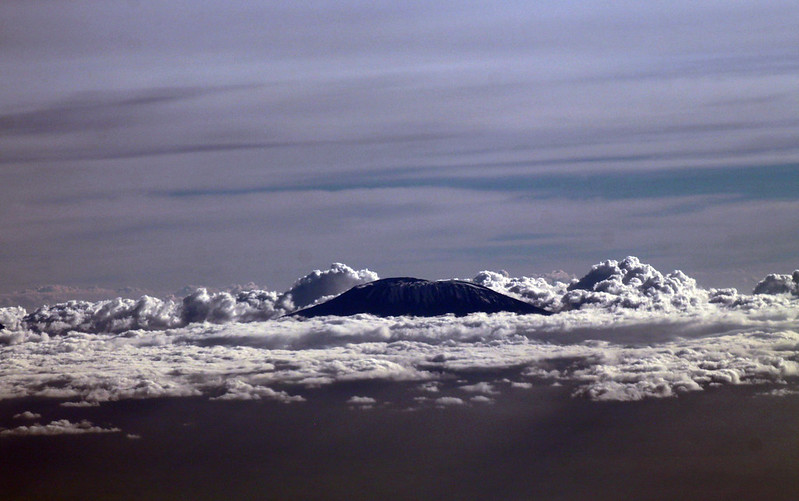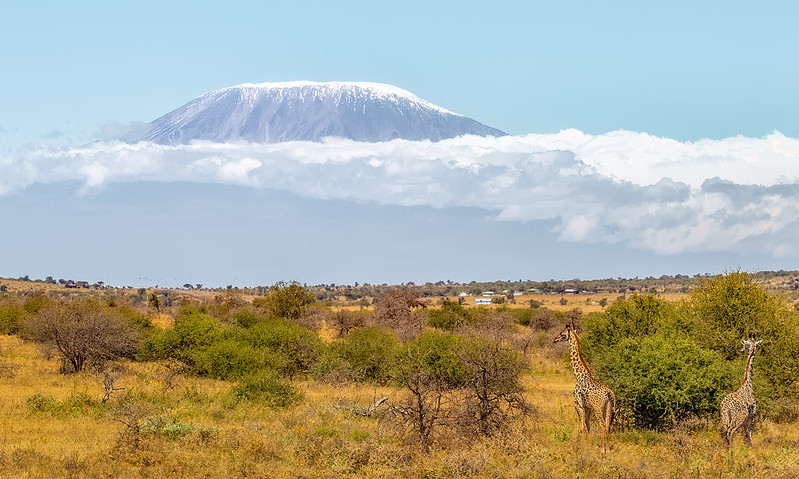The tallest Mountain in Africa
The tallest mountain in Africa is Mount Kilimanjaro, situated in northeastern Tanzania, adjacent to the Kenya-Tanzania boundary. It is an independent volcanic peak and a prominent site for hikers and adventure enthusiasts.
Mount Kilimanjaro National Park Tallest Mountain in Africa, derives its name from the magnificent Mount Kilimanjaro, the tallest mountain in East Africa and the entire African continent, with its highest summit, Uhuru Peak, reaching an elevation of 5,895 meters above sea level, commonly referred to as Kibo Peak. Mount Kilimanjaro is recognized as the largest free-standing mountain globally, whose allure draws numerous tourists, particularly adventurous travelers, to explore the park and ascend its highest peak, which is snow-capped and glistens at sunrise and sunset, observable from various locations within the park.

The mountain consists of three peaks: Shira Peak at 3,962 meters, Kibo Peak at 5,895 meters, the highest peak of Mount Kilimanjaro, and Mawenzi at 5,149 meters above sea level, featuring craters and glaciers. The entirety of Mount Kilimanjaro National Park encompasses the mountain, diverse wildlife species, forests, and flora, collectively presenting a quintessential image of natural beauty in Tanzania. Kilimanjaro National Park is located in the northern region of Tanzania, near the city of Moshi, and was founded in 1973. Kilimanjaro National Park features diverse vegetation, including montane forest, heather, alpine desert, and gentle slopes. The mountain encompasses montane forest interspersed with savanna grassland, attracting numerous wildlife species. Additionally, its elevation and the snow-capped peak further enhance Kilimanjaro National Park’s appeal as a must-visit destination during a Tanzanian safari.
Recreational pursuits in Mount Kilimanjaro National Park
Ascending Mount Kilimanjaro: Reaching the apex of the highest peak on the African continent is a quintessential aspiration for visitors, attainable just by visiting Mount Kilimanjaro National Park in Tanzania Tallest Mountain in Africa. The ascent to the top commences at the base of the mountain within the park, showcasing a variety of landscapes from the rainforest to the moonscape at the summit. The vegetation on Mount Kilimanjaro includes tropical rainforests near the base, which host many wildlife species encountered by tourists during their ascent to the summit, including buffaloes, elephants, and several bird species. During the journey through the tropical forest, the vegetation gradually transforms as the trees decrease in number, giving way to sparse moorlands at approximately 3,100 meters above sea level, commonly referred to as uplands. At approximately 4,000 meters, the vegetation transitions to alpine desert, characterized solely by flowers and mosses, while oxygen levels diminish, perhaps due to the frigid temperatures at the mountain’s summit. Beyond the Alpine desert lies a moonscape over 5,000 meters in elevation, where one can be assured of reaching Africa’s highest summit, Uhuru Peak, at 5,895 meters. The oxygen level is currently quite low. Seven principal routes are utilized by hikers on Mount Kilimanjaro: Lemosho, Marangu, Machame, Rongai, Mweka, Umbwe, and Shira routes. All these paths converge at the Summit of Uhuru Peak.

Checklist for Mount Kilimanjaro Trekking
As the tallest peak in Africa, and considering that temperatures decrease with altitude, trekkers aiming to summit Kilimanjaro must bring the following essentials for a successful hike:
Sleeping bags As the peak cannot be ascended to the summit in a single day, hikers necessitate sleeping bags for overnight rest at campgrounds located along the hiking pathways.
Insulated clothing is designed to maintain body warmth at all times, as elevation increases proximity to snow. This outfit comprises a long-sleeved thermal shirt, long trousers, a warm sweater, thermal stockings, insulated gloves, a warm scarf, and a cap, among other items.
A rain jacket is necessary to include in the packing list, as rain may occur at any time during a hike.
Sufficient drinking water is typically provided by the tour operator if one utilizes their services. Water is essential for hydration, as cold winds can deplete your moisture levels; therefore, it is imperative to consume ample water to regulate your internal temperature in relation to external conditions.
A trekking stick is typically available at park headquarters; also, remember to employ porters and cooks.
Tallest Mountain in Africa, it is essential to be physically healthy for the hike, in addition to having the packing list. If you have weakness, headaches, dizziness, diarrhea, or any unexpected symptoms, you must notify the appropriate individuals and likely cease the hike for safety reasons.
Additional activities at Mount Kilimanjaro National Park
In addition to hiking and climbing Mount Kilimanjaro, the park offers wildlife watching, study of crater lakes, and guided nature tours and hikes.
Wildlife observation: Mount Kilimanjaro National Park is inhabited by numerous wildlife species, including primates, mammals, birds, and butterflies. Consequently, a wildlife viewing safari offers tourists a breathtaking perspective of these animals as they forage in the verdant vegetation at the mountain’s base, where the rich flora sustains various wildlife that reside in Kilimanjaro National Park. The fauna observed in the park comprises elephants, buffaloes, leopards, bush pigs, mongooses, baboons, monkeys, and several bird species, all situated on the moorland at the base of Mount Kilimanjaro, which is characterized by tropical rainforests.
Exploring Crater Lake: seeing Chala Lake is among the premier activities on a Tanzania safari in Kilimanjaro National Park. The remarkable hue of the water in Crater Lake, which shifts with the changing seasons, is another compelling reason to visit at least once in a lifetime.
Short Hikes: Tourists unable to ascend the highest peak of Mount Kilimanjaro may choose shorter hikes to discover distinctive attractions, such as a brief trek to the Shira Plateau, which was created by the erosion of Shira Peak. Alternatively, other short hikes that require approximately three days to complete a circuit offer rewarding experiences with unique encounters and breathtaking views of the park.
Arriving at the destination
Via roadway, Mount Kilimanjaro National Park is geographically located, allowing tourists on a northern circuit safari to conveniently incorporate a visit to the park. The closest city is Moshi, and the park also shares a border with Kenya to the south, in proximity to Arusha National Park; therefore, regardless of the route chosen, access to Kilimanjaro National Park by road is feasible.
Tallest Mountain in Africa, International tourists can arrive by flight at Kilimanjaro International Airport, located around 46 km from Arusha, or they can fly to Arusha International Airport and subsequently go to the park by road.
Accommodation in Mount Kilimanjaro National Park
Concerned about accommodation options in Mount Kilimanjaro National Park?Here are many accommodations available for tourists on a safari to Mount Kilimanjaro National Park, catering to luxury, budget, and midrange vacationers. The list encompasses hotels, lodges, camps, and camping sites, including Kilemakyaro Mountain Lodge, SalineroMillie Lodge, Mount Kilimanjaro View Lodge, Kilinopark Hotel Machame Gate, Aishi Machame Hotel, Shanty Town Doctors Home, Amans Hotel, Kilimanjaro Whitehouse Hotel, along with various camps and camping sites.
